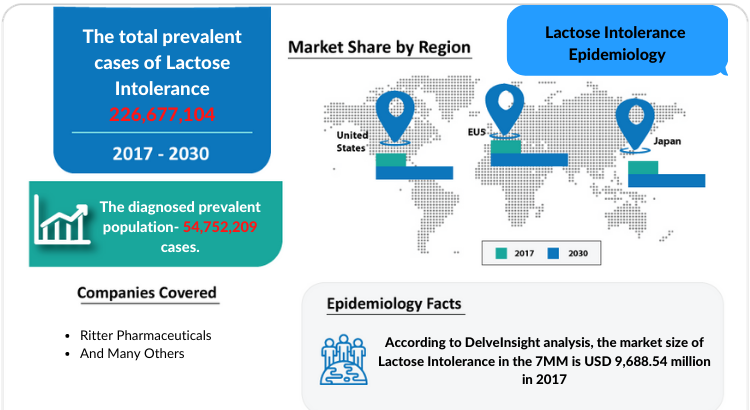“LACTOSE INTOLERANCE Epidemiology” report has been added to DelveInsight
Overview of Lactose Intolerance epidemiology, pathophysiology, various diagnostic approaches, and treatment algorithm, including detailed chapters for marketed products and emerging therapies
Download free sample copy- https://www.delveinsight.com/sample-request/lactose-intolerance-epidemiology-forecast
Lactose Intolerance: Overview
Lactose Intolerance (LI) is defined as a clinical syndrome characterized by pain and abdominal distention, flatulence, and diarrhea that occurs after lactose consumption. These symptoms—produced by malabsorption of lactose, a sugar found in milk and other dairy products—often result in avoidance of dairy products by afflicted individuals. Lactose malabsorption occurs because of a decreased ability to digest lactose, due to a deficiency in the levels of the enzyme lactase. Lactase breaks lactose down into two simpler sugars, glucose and galactose, which are readily absorbed into the bloodstream. This enzyme is produced by expression of the lactase-phlorizin hydrolase gene in the cells lining the small intestine.
Lactose Intolerance: Geography Covered
- The United States
- EU5 (Germany, France, Italy, Spain, and the United Kingdom)
- Japan
Key facts of Lactose Intolerance Epidemiology Report
- According to DelveInsight, the total prevalent cases of Lactose Intolerance (LI) in the 7MM was found to be 226,677,104 in 2017.
- In 2017, the diagnosed prevalent population of Lactose Intolerance in 7MM was found to be 154,752,209 cases.
- Severity of Lactose Intolerance as ‘Mild’ and ‘Moderate to Severe’ is based on the symptoms, defined as diarrhea, gas, bloating and cramps. There were total 22,293,305 mild and 9,554,274 moderate to severe cases of Lactose Intolerance in 2017 in the United States.
- In 2017, there were 84,726,469 prevalent cases of Lactose Intolerance in Japan. Out of which, accounts for approximately 39.0% of total diagnosed cases, for Lactose Intolerance, in the 7MM countries. In 2017, Japan witnessed 59,650,499 cases for Lactose Intolerance.
- There were total 154,752,209 severity-specific (Mild, Moderate to Severe) cases of Lactose Intolerance in 2017 in 7MM.
Lactose Intolerance Epidemiology Segmentation
- Total Prevalent Population of Lactose Intolerance in 7MM (2017–2030)
- Total Diagnosed Prevalent Population of Lactose Intolerance in 7MM (2017–2030)
- Severity-Specific Diagnosed Prevalence of Lactose Intolerance in 7MM (2017-2030)
Lactose Intolerance Epidemiology Report
Lactose intolerance is mainly caused by genome-diet interaction and depends not only on the expression of lactase enzyme but also on the dose of lactose intake, intestinal flora, gastrointestinal motility, small intestinal bacterial overgrowth. Along with this, the sensitivity of the gastrointestinal tract to generate gas and other fermentation products due to lactose digestion.
Lactose Intolerance Types
There are two types of lactose intolerance in babies: primary and secondary lactose intolerance. Primary lactose intolerance (or congenital lactose intolerance) is a very rare genetic condition. While, secondary lactose intolerance occurs when the gut lining (where lactase is produced) is damaged.
Lactose Intolerance Report Highlights
- 11-Year Forecast of Lactose Intolerance epidemiology
- 7MM Coverage
- Total Cases of Lactose Intolerance
- Total Cases of Lactose Intolerance according to segmentation
- Lactose Intolerance Diagnosed Cases
Download free sample copy- https://www.delveinsight.com/sample-request/lactose-intolerance-epidemiology-forecast
Following is the TOC of Lactose Intolerance epidemiology report
1. Key Insights
2. Executive Summary of Lactose Intolerance
3. Lactose Intolerance: Disease Background and Overview
4. Patient Journey
5. Epidemiology and Patient Population
6. Treatment Algorithm, Current Treatment, and Medical Practices
7. KOL Views
8. Unmet Needs
9. Appendix
10. DelveInsight Capabilities
11. Disclaimer
12. About DelveInsight
Why should you buy this report?
- Develop business strategies by understanding the trends shaping and driving the global Lactose Intolerance market
- Quantify patient populations in the global Lactose Intolerance market to improve product design, pricing, and launch plans
- Organize sales and marketing efforts by identifying the age groups and sex that present the best opportunities for Lactose Intolerance therapeutics in each of the markets covered
- Understand the magnitude of Lactose Intolerance population by its epidemiology
- The Lactose Intolerance Epidemiology Model developed by DelveInsight is easy to navigate, interactive with dashboards, and epidemiology based with transparent and consistent methodologies. Moreover, the model supports data presented in the report and showcases disease trends over 11-year forecast period using reputable sources
Media Contact
Company Name: DelveInsight Business Research LLP
Contact Person: Vinita Rakheja
Email: Send Email
Phone: 9193216187
Address:304 S. Jones Blvd #2432
City: Albany
State: New York
Country: United States
Website: www.delveinsight.com/

